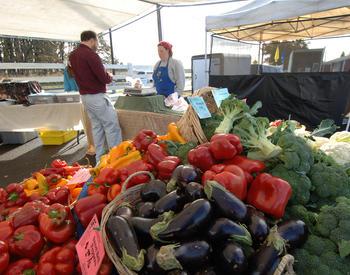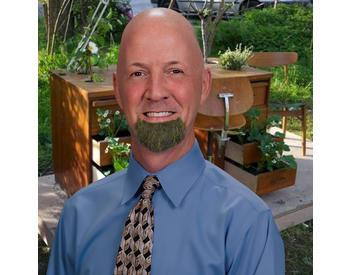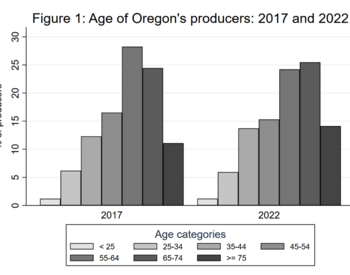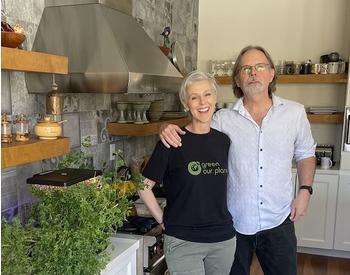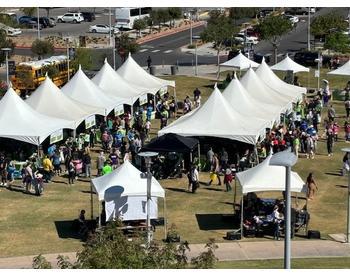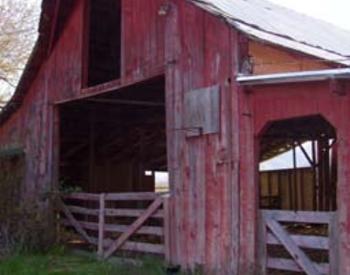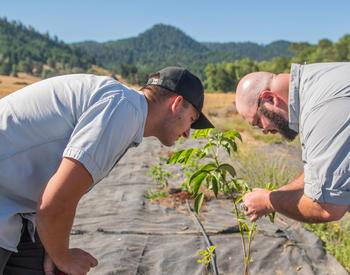SALEM, Ore. – It’s a few minutes after 6 p.m. and the planners of the Broken Stone Creamery are going over their presentation notes.
Dakota Crow, Ty Adams and Braden Kingsley have gone over every aspect of the operation. Their plan included an annual budget, how they would acquire equipment, how they would establish the farm’s infrastructure and how they would manage day-to-day operations.
They created the hypothetical farm in a class at the Oregon State Correctional Institution that used a book written by Garry Stephenson, the founder of Oregon State University Extension Service’s Small Farms Program. The book guides aspiring and beginner farmers through making smart business decisions to ensure lasting success.
Twenty inmates at the prison in Salem took the class, which met once a week over four months. The class was taught by Kate Bildsten, education manager for Lettuce Grow, a program that brings garden-based knowledge to Oregon incarcerated students. Other OSU Extension classes offered through Lettuce Grow include a six-week Seed to Supper class and a 14-week sustainable gardening class, for which graduates earn a Certificate of Home Horticulture from OSU Extension.
About a year ago, Bildsten contacted Lauren Gwin, director of OSU’s Center for Small Farms & Community Food Systems, about using Stephenson’s book, “Whole Farm Management: From Start-Up to Sustainability.” Stephenson donated 20 copies of the book to use for the class.
“This was pretty new for me,” Bildsten said. “I never started a small farm. What was beautiful about this was we were all learning together.”
Presentation day
June 11 was presentation day for the Growing Farms students.
Standing in front of the class under a screen with PowerPoint slides, Crow, Adams and Kingsley took turns describing Broken Stone Creamery.
The creamery would be located outside of Terrebonne in Deschutes County and powered by wind turbines. It would feature high-end dairy products such as cheese infused with herbs, berries and coffee. They would use social media and word-of-mouth to sell their products to employees of a large tech firm that recently built a campus nearby.
Each of the other four farms created in the class had a different focus. But each featured recurring themes from Stephenson’s book: environmental stewardship, financial sustainability and detailed budgeting record-keeping.
Emerald Owl Farms would be an “ecofriendly, ethical” farm on the Luckiamute River in the Willamette Valley. The farm would focus on growing yellow vegetables, such as corn, squash, peppers and beans, which are packed with antioxidants and valued for their health benefits.
Simple Farms’ mission would be to serve families and the community. Located on just 1½ acre, vegetable crops would grow beside a goat pasture and chicken coops. The farm would use hoop houses and tunnel covers to extend growing seasons.
The 10-acre Five Colts Farm in Benton County would have a mission to “put seeds in the hands of everyone.” They would grow fruit trees and berries and raise quail and chickens.
Instead of producing food, Rising Sun Eco Farms would produce power by installing solar panels on agricultural fields.
“Great job everybody,” Bildsten said after the last group finished. “You did it.”
‘Thinking big’
Stephenson, who attended the final class, was intrigued by coffee-infused cheese and smiled and chuckled at Emerald Owl Farms’ idea of having a pair of wolverines to attract visitors to the farm.
Asked to provide his closing thoughts, Stephenson said he was impressed by what he heard.
“First of all, fabulous job, guys,” he said, leaning on a table at the front of the class. “Overall, a theme I heard again and again was that you all were thinking big. You weren’t just thinking in terms of a for-profit business. Every one of you were thinking about taking care of yourselves, your families and your communities.”
It was clear they all read the whole book, not just the chapters that interested them, Stephenson said.
The inmates at the Oregon State Correctional Institution don’t have access to the internet. Bildsten would supplement Stephenson’s book with paper handouts and videos. One of the students also gained knowledge through phone calls with family members who are farmers.
The class featured a guest lecture from Beth Hoinacki of Goodfoot Farm in Philomath, who had “an extremely informative and useful question-and-answer session with the students about all things farming,” Bildsten said.
“There were things in the book that really interested them,” Bildsten said. “I followed up with information. They learned a lot. Only a few of those guys have any farming experience.”
One of them was Crow, who worked on his family ranch before being incarcerated, and Luis Salas, who had experience picking fruit in Hood River County orchards.
“In this class, I brought the understanding of unity,” Salas said. “How we could make it happen if we worked together.”
Crow, who was in a core group who helped plan the class with Bildsten, said his grandmother has promised him that he would be in charge of the family ranch after he leaves prison.
“I thought it would be cool to inform people that there are opportunities in farming,” he said. “This is a great career path that they could follow. Almost all of them had zero ag background. I wanted to be able to shine a light on agriculture. It was super cool to see it all come together.”
June 18 was graduation day. The students received certificates signed by Stephenson.
“The same certificates that people on the outside get,” Bildsten said.
